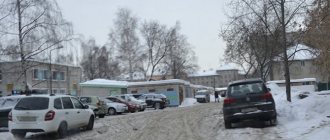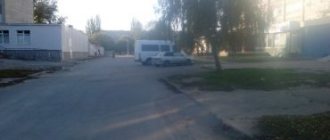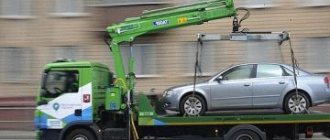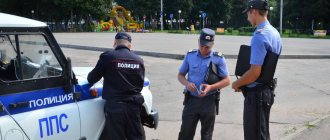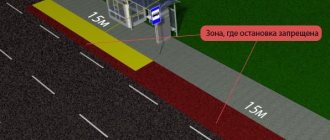When should you stop?
Situations when a driver has the right to ignore a stop request from a traffic police officer are regulated at the legislative level.
First of all, you should determine where the traffic police officer stopped you. There are designated places for this purpose, equipped with buildings and premises. An adjacent section of road approaches them.
In what cases can a tenant be discharged from an apartment against his will? Let's figure it out
If you are given a sign to stop at such a place, you are obliged to do so, otherwise you will face penalties. The reasons for the stop can be very varied, for example, checking your documents.
In addition to the stationary post, traffic police officers can brake cars directly on the roadway. However, in this case there is a limited list of powers to stop vehicles.
Possible reasons for stopping:
- you violated traffic rules;
- suspicion that your car is stolen;
- suspicions of fleeing the scene of a traffic accident, etc.
A complete list of acceptable grounds for braking by traffic police officers can be found on the traffic police website. Otherwise, if the reasons are different, then the stop can be regarded as a violation of internal discipline.
Can traffic police stop just to check documents in 2021? Reason for traffic stop
Until 2021, Order No. 185 of the Ministry of Internal Affairs of Russia was in force, where in paragraph 65 it was stated that the basis for stopping a vehicle by a traffic police officer was a check of documents for the right to drive a car and in brackets it was explained that on this basis it was possible to stop only at stationary traffic police posts.
In 2021, this order was canceled due to the adoption by the Ministry of Internal Affairs of a new order number 664.
After reading this order, many motorists and lawyers came to the conclusion that traffic police officers no longer have the right to simply stop a car to check documents.
Now I’ll explain where they come from.
The list of grounds for a traffic police officer to demand that the driver stop a vehicle is provided for in clause 84 of the Administrative Regulations.
It contains as many as 14 reasons for stopping a vehicle.
According to subclause 84.13 of the Administrative Regulations, the basis for a traffic police officer to demand that the driver stop a car are: Checking documents for the right to use and drive a vehicle, documents for the vehicle and the cargo being transported.
But, in the same regulations, there is paragraph 106, which lists the grounds for checking documents, there are four of them, these are:
- identifying signs of traffic violations;
- presence of clues or information about the driver’s involvement in an accident, crime, or suspicion that the car is wanted;
- carrying out measures to prevent road accidents;
- and the last and most important point is stopping the vehicle on the grounds provided for in subparagraphs 84.1, 84.2, 84.3, 84.11 of the Administrative Regulations.
As you can see, in the last paragraph there is no mention of paragraph 84.13.
Consequently, many concluded that a traffic police officer does not have the right to simply stop a car to check documents.
But, judicial practice took a different path and the courts, as part of the proceedings, recognized stopping a vehicle on the basis of clause 84.13 as legal.
The Supreme Court put an end to this dispute.
At the end of 2021, a hero of our time, a certain Rudakov Konstantin Pavlovich, appealed to the Supreme Court with a demand to invalidate subclause 84.13 of the Administrative Regulations regarding the establishment of the possibility of stopping a vehicle for the purpose of checking documents outside stationary posts, citing its contradiction with Part 1 of Article 56 of the Russian Constitution Federation, Article 27.3 of the Code of Administrative Offenses, and most importantly, paragraph 106 of the Administrative Regulations.
Unfortunately, all of Konstantin Rudakov’s arguments were rejected by the court and he lost the trial.
Regarding the contradiction between clause 84.13 and clause 106 of the Administrative Regulations, the court said that Rudakov’s argument about the contradiction of these clauses has no legal significance due to the fact that both provisions are different parts of the same normative legal act and have equal legal force.
This decision of the Supreme Court has become a beacon that all Russian courts are now guided by, despite the obvious confusion within the Administrative Regulations. A link to this court decision is in the description of this video.
Thus, we can conclude that the Administrative Regulations approved by Order of the Ministry of Internal Affairs No. 664 allow traffic police officers to stop a vehicle outside a stationary post to check documents. In this connection, police officers have the right to stop the car to check documents anywhere.
If you didn’t know this, be sure to send this video to your friends and let them watch it, because... 99% of all articles and videos on YouTube say that traffic police do not have the right to stop vehicles to check documents and thus they deceive people, and this can lead to very bad results, because the courts have a different position.
When can you not stop?
Situations where the driver has the right not to respond to the signs of a traffic police officer and drive further are enshrined in law. If you do not stop, this will not entail any sanctions.
In what cases can children over 18 years of age qualify for child support?
You are not required to stop in the following cases:
- You have the right to drive past a traffic police officer without even reducing the speed limit if the signal was given outside a stationary checkpoint at night. But to be safe for the future, so as not to worry about negative consequences, it is recommended to stop near the nearest post and report that they wanted to stop you.
- You don’t have to stop if stopping your car threatens its safety. For example, you are given a sign to stop, but you understand that the situation on the road is such that stopping will lead to an accident. Therefore, you can safely move on. But there is a small nuance here; then it is very difficult to prove an increased risk of an accident. And it is almost impossible to predict how everything will turn out in the future.
Traffic police officers do not have the right to stop cars on a section of the road that is characterized by limited visibility. These sections of the route include the places before and after the turn.
It is also prohibited to stop the car before an intersection or traffic light, before and after the top of a rise, and in other dangerous places.
So, if you see a traffic police inspector standing outside his stationary post, before stopping, it is recommended to carefully study the place and situation. It is possible that you have every right not to stop the car and drive on.
Reasons for stopping a vehicle by traffic police officers in 2021 in the Russian Federation
Dear car enthusiasts, most of you probably don’t know that you can’t just stop your car. Today I would like to consider all the legal reasons for stopping a vehicle by traffic police officers in 2021 in the Russian Federation. According to paragraph 84 of Order of the Ministry of Internal Affairs of Russia dated August 23, 2017 N 664, a traffic police officer can stop your vehicle only on the basis of the reasons below.
Reasons for stopping a vehicle by traffic police officers in 2021:
- Signs of violations of road safety requirements identified visually or recorded using technical means.
- Availability of data (orientations, information from the duty officer, other squads, road users, visually recorded circumstances) indicating the involvement of the driver and passengers in the commission of an accident, crime or administrative offense.
- Availability of data (orientations, information from operational and investigative records of internal affairs bodies, information from the duty officer, other squads, road users) about the use of the vehicle for illegal purposes or grounds to believe that it is wanted.
- The need to interview the driver or passengers about the circumstances of the accident, administrative offense, crime of which they were or are eyewitnesses.
- The need to involve a road user as a witness.
- The need to use a vehicle.
- The need to temporarily restrict or prohibit the movement of vehicles.
- The need to ensure safe and unhindered passage of special purpose vehicles.
- Providing assistance in the unimpeded passage to the scene of emergency medical vehicles, as well as vehicles of operational and other emergency services involved in the liquidation of emergency incidents.
- The need to involve the driver and (or) passengers to assist other road users or police officers.
- Carrying out, on the basis of administrative acts of the heads of territorial bodies of the Ministry of Internal Affairs of Russia at the regional (district) level, heads of departments of the State Traffic Inspectorate of the territorial bodies of the Ministry of Internal Affairs of Russia at the regional (district) level, measures to prevent road accidents and reduce the severity of their consequences in order to protect life, health and property citizens, protection of their rights and legitimate interests, as well as the interests of society and the state.
- A threat to road safety created by a malfunction or improper installation of technical means of traffic management, violation of the rules for carrying out repair work on the road, a natural disaster, an industrial (man-made) accident, a fire and other emergency circumstances, or a leak of hazardous substances.
- Checking documents for the right to use and drive a vehicle, documents for the vehicle and the cargo being transported.
- Checking the identity documents of the driver and passengers, if there is data giving grounds to suspect them of committing a crime or to believe that they are wanted, or if there is a reason to initiate an administrative offense case against these citizens, as well as if there are grounds for their detention in cases provided for by federal law.
Now traffic police officers can stop a car to check documents not only at a stationary checkpoint
When the inspector gives you a signal to stop, he must indicate a specific place, and this section of the road should not prohibit stopping.
When giving signals to stop, the location where the vehicle will stop must be indicated.
Clause 86 of Order of the Ministry of Internal Affairs of Russia dated August 23, 2017 N 664
It is not allowed to stop vehicles on sections of roads where stopping them is prohibited by traffic rules, except in cases where such a stop is related to the need to suppress a crime, administrative offense, carry out administrative and regulatory actions, prevent a real threat of harm to life, health and (or ) the property of road users, as well as cases of marking a stopping place by a patrol car with special light signals and other means of regulating and organizing traffic.
If it is necessary to stop vehicles in places where their stopping is prohibited by traffic rules, the employee takes measures to ensure road safety in this place.
Clause 88 of Order of the Ministry of Internal Affairs of Russia dated August 23, 2017 N 664
Legal consultation
Get qualified help right now! Our lawyers will advise you on any issues out of turn!
To get a consultation
If a police officer needs your car, he is obliged to tell you the purpose and route, while you remain the driver. To chase persons who have committed any violation, the inspector is obliged to use his official car.
If it is necessary to use a vehicle, the employee informs the driver about this, indicating the purpose of use, the route of travel (except for cases when the vehicle is necessary to pursue persons who have committed crimes) and invites the driver to provide him with the vehicle, explaining, in case of refusal, responsibility for failure to comply of this requirement, provided for by the legislation of the Russian Federation. The vehicle being used is controlled by the driver himself in the absence of grounds for his removal from driving the vehicle. The employee who has used the vehicle, at the driver’s request, issues him a certificate or makes an entry on the waybill indicating the duration of the trip, the distance traveled, his last name, position, employee number certificates, names of the State Traffic Inspectorate unit (DPS unit).
Clause 90 of Order of the Ministry of Internal Affairs of Russia dated August 23, 2017 N 664
The vehicle may also be forced to stop. The following means are used for this:
- Special means of forced stop in case of danger. Such means are batons, gas canisters, pistols, stun guns, etc.
- Special signals (traffic lights, traffic controller) to restrict or prohibit movement.
- Blocking traffic using a patrol car with lights on.
- If there is a real danger (the driver has committed a crime or in self-defense), then the car can be stopped using a firearm.
Perhaps, these are all the reasons for stopping a vehicle by traffic police officers in 2021, but I would really like to tell you about one more nuance. Previously, covert patrols were popular, when a car is used without special painting, but the driver is dressed in a standard uniform. From now on everything has changed. Stealth patrols are now prohibited.
The pursuit is carried out in a patrol car with special light and sound signals turned on. In this case, the request to stop is given using a loud-speaking device or a hand gesture, if necessary using a rod or a disk with a red signal (reflector). If necessary and if possible, other road users are informed (using a loudspeaker device) about increased caution and compliance with safety precautions.
Clause 96 of Order of the Ministry of Internal Affairs of Russia dated August 23, 2017 N 664
Finally, I would like to remind you that the inspector is obliged to approach you after stopping the vehicle, exclusively from the driver’s side, unless there are any objective circumstances that could prevent this. Then, introduce yourself, give your last name, position and title, and only then the reason for the stop.
